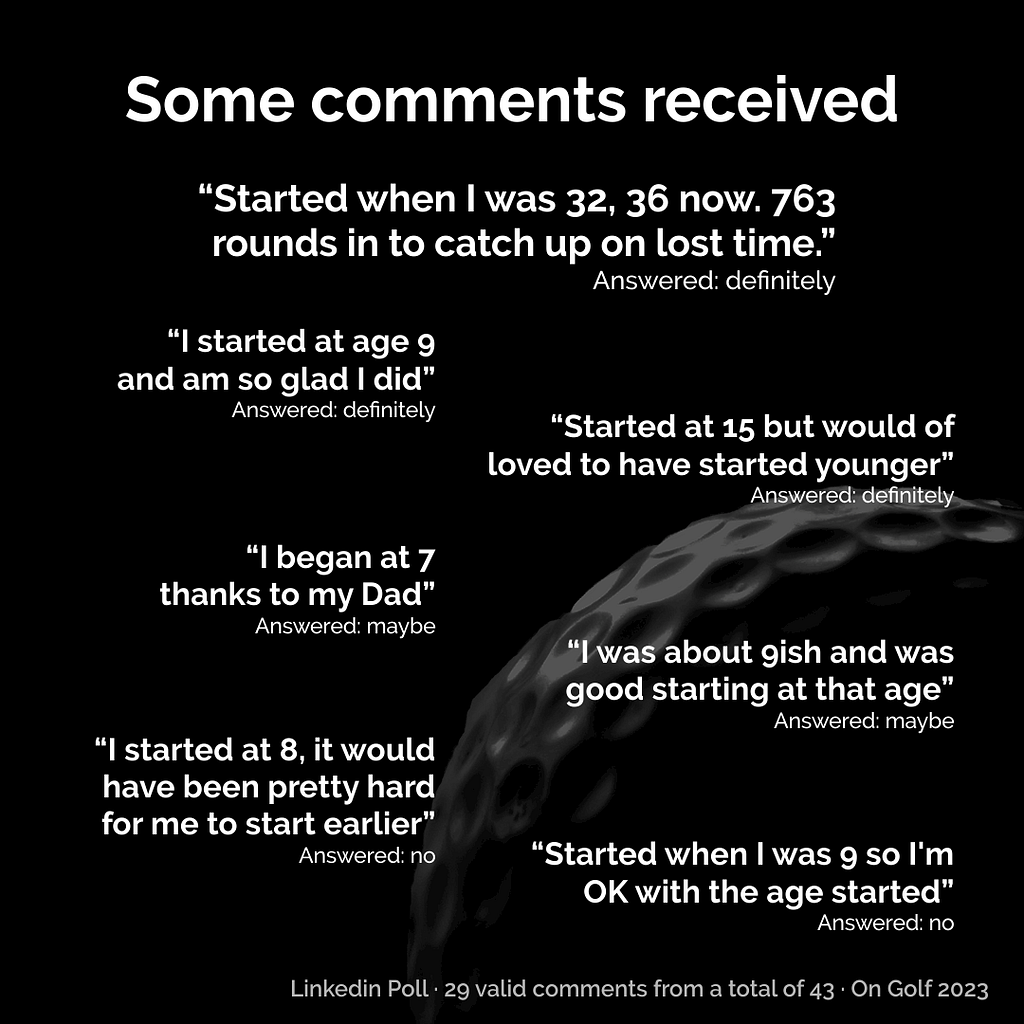

“I really wish I had started playing golf when I was younger” is a frequently heard lament among golfers. If you are a golfer, there is a good chance that you share this feeling or know someone who does. But just how common is it, and what implications does it have for the golf industry?
Turns out it’s devastatingly common. According to a Linkedin poll, a staggering 86% of golfers admit that they definitely wish they had taken up the game when they were younger.
Almost nine out of ten. You read that right.
The poll was performed among the members of one of the most popular Linkedin groups dedicated to golf and consisted of a single question: Would you like to have started playing golf at a younger age?, with three possible answers: Definitely, Maybe or No.
The following graph is self-explanatory:

In order to gain more insight, the respondents were also asked to state the age they started playing by writing it in the comments section of the poll.
Unfortunately, there were only 29 valid responses. While representing a small sample, still allow for some interesting observations to be made.
The following graph shows the minimum, maximum and average values of reported age of initiation of playing, segmented by survey response:

It can be clearly observed that this regret, which, for lack of a better term, could be described as some kind of inverse consumer remorse, increases both in frequency and intensity the later in life a golfer starts playing.
Of the group of players who show no regret, it is easy to hypothesize why: they were already very young when they were introduced to the game.
Nonetheless, it is interesting to note that in the first group there is one person who, despite having started playing at the age of nine, still regrets not having started earlier.
The following chart shows some of the comments collected to give a better idea of the sentiment expressed by players:

What does this mean for the golf industry?
Let’s get something clear first. What nearly ninety percent of the respondents are basically saying is: “We love your product, but we also feel bad for all the time we didn’t get to enjoy it because we didn’t know how good it was.”
“We love your product, but we also feel bad for all the time we didn’t get to enjoy it because we didn’t know how good it was.”
This is probably one of the most shocking statements about consumer sentiment you will ever come across.
If the golf industry were a single company in any other industry, this statement alone would be grounds for the dismissal of the entire management team, but for the golf industry, this is just business as usual.
Ironically, the root of the problem may be found in the game of golf itself: it is simply too good of a product for its own good.
So good, in fact, that it has historically managed to sell itself thanks to the amazing loyalty it generates among golfers, who are eager to share their excitement about the game with their friends and family.
A second survey was conducted to validate this idea. This time involving member of several golf-related Linkedin golf groups with the following question: How you were introduced to the game? The possible answers were: Friend / Family Member / Coworker; By my own curiosity about golf; Golf Industry Event / Campaign and Other.
Here are the results:

As predicted, friends, family members and work colleagues are the major driving force driving the growth of the game with a 75% of the results. It is interesting to observe that almost 20% of people get attracted to the game by their own curiosity.
Only 3% of the respondents claim that it was the golf industry that made them get in contact with the game.
While this was an expected result, it must be acknowledged that it is nonetheless an extraordinary achievement for a multi-million dollar global industry. If there is an example of successful word-of-mouth marketing, it is golf.
“If there is an example of successful word-of-mouth marketing, it is golf.”
But there’s a dark side to all of this. The industry has become accustomed to doing little or nothing to attract new players. The hard work is left to the players themselves, who do the job for them.
This comes with two serious disadvantages: first, golfers do it out of good will and therefore cannot be required to follow any plan or achieve any goals, and second, their reach is limited to people in their immediate social environment.
This leads to an even more ominous conclusion: there is a gigantic pool of potential players who will never be introduced to the game simply because they are not fortunate enough to have a golfer among their friends and family.
“There is a gigantic pool of potential players who will never be introduced to the game simply because they are not fortunate enough to have a golfer among their friends and family.”
Without further research, it is difficult to estimate the lost revenue that this phenomenon is causing to the golf industry on an annual basis, but one thing is for sure: we are certainly not talking about pennies.
What can be done?
The answer is clear: the industry as a whole should recognize the situation and begin to actively engage in attracting players to the game.
While it is true that hundreds of millions are spent on golf marketing and advertising each year, there is a catch: most of these campaigns target people who are already hooked by the game. Their goal is to sell to the already converted, not to attract new players.
If only a fraction of this effort were focused on attracting new players, it would increase the number of golfers, reduce the pain felt by those who arrive late to the game and, as a result, generate enormous economic benefits for the golf industry.
The players have been doing all the hard work for years. Let’s give them a hand.
They deserve it. The game deserves it.
About the author:
Germán Lechuga is an avid, though admittedly not-so-great golfer who truly believes that the game of golf is one of the best things that can happen to anyone. After reluctantly ruling out having the talent necessary to develop a career on the PGA Tour, he decided instead to give something back to the game in the form of writing.
Caveat:
Admittedly, the opinions presented in this article are based on data that represents a small sample that may not prove to be statistically significant. A larger-scale research would be necessary to confirm this information.
Image credits:
Golfer photo courtesy of cottonbro studio via Pexels
https://www.pexels.com/search/cotton%20bro/
Regret. The Dark Secret of Golf was originally published in On Golf on Medium, where people are continuing the conversation by highlighting and responding to this story.